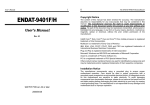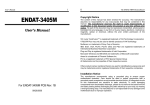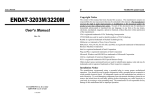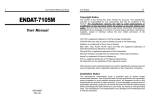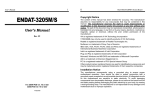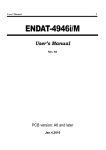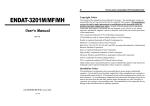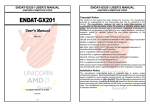Download ENDAT 4066i User`s manual
Transcript
I
User’s Manual
ENDAT-4066i
User’s Manual
II
The ENDAT-4066i System Board
Copyright Notice
The content of this manual has been checked for accuracy. The manufacturer
assumes no responsibility for any inaccuracies that may be contained in this
manual. The manufacturer reserves the right to make improvements or
modification to this document and/or the product at any time without prior
notice. No part of this document may be reproduced, transmitted, photocopied or
translated into any language, in any form or by any means, electronic, mechanical,
magnetic, optical or chemical, without the prior written permission of the
manufacturer.
Rev. 1A
Intel® Pentium4®, Celeron® and Celeron D ® is registered trademark of Intel
Incorporation
Multiscan is a trademark of Sony Corp of America
IBM, EGA, VGA, PC/XT, PC/AT, OS/2 and PS/2 are registered trademarks of
International Business Machines Corporation
Plug and Play is registered trademarks of Intel Corporation
Microsoft, Windows and MS-DOS are trademarks of Microsoft Corporation
Award is a trademark of Phoenix Software Inc.
PCI is a registered trademark of PCI Special Interest Group
Other product names mentioned herein are used for identification purpose only and
may be trademarks and/or registered trademarks of their respective companies.
Installation Notice
4066i PCB ver: A2 or later
25/05/2007
The manufacturer recommends using a grounded plug to ensure proper
motherboard operation. Care should be used in proper conjunction with a
grounded power receptacle to avoid possible electrical shock. All integrated circuits
on this motherboard are sensitive to static electricity. To avoid damaging
components from electrostatic discharge, please do not remove the board from the
anti-static packing before discharging any static electricity to your body, by wearing
a wrist-grounding strap. The manufacturer is not responsible for any damage to the
motherboard due to improper operation.
III
User’s Manual
IV
Specification:
TABLE OF CONTENTS
Model
ENDAT-4066i
Form Factor
System Chipset
Mini-ITX 170 mm x 170 mm (6.69”x6.69”)
CPU Supporting
Memory
Ethernet
VGA
533/400 FSB with 478 pin PENTIUM4/Celeron/Celeron D processor
LCD interface
INTEL 865GV + ICH5
1 x 184 pin DDR socket support DDR 400/333/266 up to 1GB
Display ratio
4:3 and 16:9
2 Serial Port w/+5V, +12V Power Selector / 1 Parallel port (Optional to 6
Serial ports via I/O kit)
Watchdog Timer
Winbond 83627THG on-chip support 1 to 255 seconds/minutes
1 x 40pin IDE connector support UDMA 33/66/100
1 x 44pin IDE connector support Slim type HDD
Support 1 port 150MHz Serial ATA Device
SATA Connector
AUDIO
CMOS backup
Expansion Slot
I/O Port
Digital IO
RS-422/485
USB Port
Power Supply
CHAPTER 1. INTRODUCTION ....................................................... 1
1-1.
1-2.
1-3.
1-4.
FEATURES .............................................................................................. 2
UNPACKING ............................................................................................ 3
ELECTROSTATIC DISCHARGE PRECAUTIONS ................................... 3
MOTHERBOARD LAYOUT ...................................................................... 4
INTEL 82801ER/EB (ICH5) + PHY (Intel 82562EX)
INTEL 865GV Graphic Controller with DVMT up to 96MB(max)
Onboard LVDS support 18/24/36/48bit Single/Dual Channels via internal
box header (optional)
Serial / Parallel
IDE Connector
The ENDAT-4066i System Board
CHAPTER 2. SETTING UP THE MOTHERBOARD ....................... 5
2-1. JUMPERS AND CONNECTORS.............................................................. 5
2-2. INSTALLING MEMORY.......................................................................... 14
2-3. SHARED VGA MEMORY ....................................................................... 14
2-4. INSTALLING RISER CARD.................................................................... 14
2-5. ASSIGNING IRQs FOR EXPANSION CARDS ....................................... 14
2-6. WATCHDOG TIMER…………………………………………………………. 15
2-7. DIGITAL I/O…………………………………………………………...………. 17
On-board support AC'97 with 1.2W amplifier
EEPROM backup customized setting in system BIOS
One PCI expansion up to 3 PCI slots via riser card with PCI 2.2 compliance
PS/2 Keyboard / Mouse Connector
2 x USB (2.0) + RJ-45 Connector w/LED indicator
D-sub Connector for COM 1,2 (internal box header for COM2) with
POWER
1 x 25 Pins D-Sub Connector (LPT)
1 D-Sub Connector (VGA)
MIC-IN, Line-In, SPK-Out with COM2 Module Deck
Internal pin header: KB, MS, USB (2.0) x4, AUX/CD-IN, SPDIF IN/OUT, RF
MIC IN, IR
2 bit input and 2 bit output (TTL level) by pin header
Via COM2 (Optional)
6 x USB2.0 onboard
Support P4-ATX power supply
CHAPTER 3. AWARD BIOS SETUP............................................. 18
3-1. STANDARD CMOS FEATURES............................................................. 19
3-2. ADVANCED BIOS FEATURES............................................................... 20
3-3. ADVANCED CHIPSET FEATURES ........................................................ 21
3-4. INTEGRATED PERIPHERALS............................................................... 23
3-5. POWER MANAGEMENT SETUP........................................................... 27
3-6. PnP/PCI CONFIGURATIONS................................................................. 28
3-7. PC HEALTH STATUS ............................................................................. 29
3-8. FREQUENCY/VOLTAGE CONTROL ..................................................... 29
User’s Manual
V
CHPATER 4. VGA, LCD, FEATURE.............................................. 31
4-1. VGA FEATURE....................................................................................... 31
4-2. LVDS PANEL AND TV FEATURE........................................................... 32
4-3. PCI BUS AUDIO ADAPTER FEATURES................................................ 33
4-4. DRIVER UTILITY INSTALLATION GUIDE ............................................. 34
CHPATER 5. LAN ADAPTER ........................................................ 35
5-1. FEATURES ............................................................................................ 35
5-2. UTP CABLE/RJ-45 JACK DEFINITION .................................................. 36
5-3. CONNECTING 100BASE-TX FAST ETHERNET NETWORK ................ 37
5-4. CONNECTING 10BASE-T ETHERNET NETWORK .............................. 37
5-5. 10MBASE/ 100MBASE INSTALLATION NOTICE .................................. 37
5-6. REMOTE BOOT ROM FUNCTION ........................................................ 38
5-7. LED INDICATORS.................................................................................. 38
APPENDIX A: FLASH MEMORY UTILITY.................................... 39
APPENDIX B: CONNECTOR PIN ASSIGNMENT ........................ 40
APPENDIX C: UC-COM56 JUMPER SETTING............................ 41
APPENDIX D: LIMITED WARRANTY ........................................... 42
User’s Manual
1
Chapter 1. Introduction
ENDAT-4066i supports high performance processor of Intel® Pentium4®,
Celeron® and Celeron D ® with 400 and 533 Front Side Bus. It also supports high
speed DDR memory with 64-bit wide interfaces with non-ECC DIMM (up to 1GB).
Only Double Data Rate (DDR) SDRAM memory is supported and the speed of
memory can be 266, 333 and 400 MHz.
ENDAT-4066i provides an integrated graphics (Intel® Extreme Graphics 2)
accelerator delivering cost competitive 3D, 2D, and video capabilities.
ENDAT-4066i video engines support video conferencing and other video
applications. Instead of a dedicated local graphics memory interface, ENDAT-4066i
uses a UMA configuration for optimal memory utilization and performance that
deliver 3D graphics with sharp images, fast rendering, smooth motion and extreme
detail.
ENDAT-4066i contains one integrated Serial ATA host controllers capable of
independent DMA operation on two ports. The SATA controllers are completely
software transparent with the IDE interface, while providing a lower pin count and
higher performance. The data transfer rate is up to 150 MB/s.
ENDAT-4066i is an ideal model for various kind of application:
- POS system
- KIOSK
- Interactive system
- Airport Terminal Controller
- Industrial controller
- Digital entertainment
- Embedded system equipment
2
The ENDAT-4066i System Board
1-1. Features
Basic Feature:
z
z
z
z
z
z
z
z
z
z
z
z
Board format: Mini-ITX (170mm x 170 mm)
Supports Socket 478 CPU (FSB 533/400 MHz)
Digital I/O: 2 bits in and 2 bits out (3.3V)
Supports DDR 266/ 333/ 400 SDRAM up to 1GB
Serial ATA connector x 1
Enhance IDE connector x 2
Multiple I/O ports: COM port x 2; USB (2.0) x 6
All COM ports with +5V, +12V power selector
CMOS backup: EEPROM backup
Watchdog Timer
Intel 10/100 LAN and Audio function onboard
With Intel embedded ATX PCI expansion design
Optional features:
z
z
z
z
On board chip provides LVDS interface (18/24/36/48 bit, single/dual
channels) or TV out signals (composite and S-video)
Second I/O kit for extra 4 COM ports (COM3 to COM6)
RS 422/485 via COM 2
Barebones system: niche into Unicorn U-8000 Chassis
Full Software Support:
z Drivers for major operating systems and APIs: Windows 9x / ME,
Windows 2000, Windows XP, Direct3D, DirectDraw and DirectShow,
OpenGL ICD for Windows 9x, and 2000, and DXVA for Windows
2000 and Windows XP
User’s Manual
3
1-2. Unpacking
The motherboard comes securely packaged in a sturdy cardboard shipping carton.
In addition to the User's Manual, the motherboard package includes the following
items:
ENDAT-4066i System Board
HDD / IO Cables
LCD cable (Optional)
CDROM Driver includes: Drivers for Windows 98, ME, 2000, XP and AMI / AWARD
FLASH ROM utilities.
Driver utilities for on-board VGA drivers, LAN adapter
If any of these items are missing or damage, please contact the dealer from whom
you purchase the motherboard. Save the shipping material and carton in the event
that you want to ship or store the board in the future.
Note: Please leave the motherboard in its original package until you are
ready to install it!
1-3. Electrostatic Discharge Precautions
Make sure you properly ground yourself before handling the motherboard, or other
system components. Electrostatic discharge can easily damage the components.
Note: You must take special precaution when handling the motherboard in dry or
air-conditioned environments.
4
1-4. Motherboard Layout
The ENDAT-4066i System Board
5
User’s Manual
Chapter 2. Setting up the Motherboard
2-1. Jumpers And Connectors
Jumpers/Connectors Overview:
Function
Cooling Fan Connector
P4 Power Supply Connector 2*2
P4 Power Supply Connector 2*10
LCD Panel Connector
LCD Voltage Selector
Clear CMOS
Pin Header for external device
PS/2 Mouse/KB Pin Header
PS/2 Mouse/KB
USB Port
IDE 1, IDE 2
SATA 1
IDE active LED
External Speaker
Buzzer On/Off
Hardware Reset Switch
Power LED
ATX Power Supply On/Off Switch
WDT Function Enable/Disable
SATA LED
DDR SDRAM socket
LAN Connector
CRT Output
Power Good Selector
COM1 & COM2 Voltage Selector
COM1
COM2
LPT1
MIC In, Line In, Line Out
COM2 Pin Header
RS232 / 485 Selector for COM2
Jumpers/Connectors
FAN1, FAN2
CN2
ATXPWR
LVDS1
JP6
JBAT1
JP1
J1
CN1
CN3, J3, J4
IDE1, IDE2
SATA1
J9: Pin 1(-), Pin 2(+)
J9: Pin 3, Pin 6
J9: Pin 4, Pin 5
J9: Pin 7, Pin 8
J9: Pin 9(+), Pin 10(-)
J9: Pin 11, Pin 12
J9: Pin 13, Pin 14
J9: Pin 15(+), Pin 16(-)
DIMM1
CN3
CN6
JP2
JP4
CN4
CN8D1
CN5
CN7
J2
JP3 & JP5
6
The ENDAT-4066i System Board
Function
DIGITAL I/O Pin Header
CD In & Line Out Pin Header
Microphone IN & LINE IN Pin Header
LPC Super I/O Connector
Jumpers/Connectors
J5
J6
J7
J8
Please double-check the insertion and orientation of the LCD cable
before applying power. Improper installation will result in permanent
damage LCD panel.
Part 1: Onboard Jumpers
JP1: Pin Header for external device (2.0mm)
Pin No.
Signal (MS)
Pin No.
Signal (KB)
MS Data Out
KB Data Out
1
2
MS Data In
KB Data In
3
4
MS Data Out
KB CK Out
5
6
MS CK In
KB CK In
7
8
KEY
KEY
9
10
+5V(DC)
+5V(DC)
11
12
GND
GND
13
14
Default setting is: 1-3, 5-7, 2-4 and 6-8 closes
JP2: Power Good Selector (2.0mm)
Pin 1-2 *
External Power Good (Default)
Pin 2-3
Internal Power Good
JP3, JP5: RS232 / 422 / 485 Selector for COM2 (2.0mm)
TYPE
JP5 (3x4/2mm)
JP3 (2x3/2mm)
1-2, 4-5, 7-8, 10-11
1-2
RS-232 *
2-3, 5-6, 8-9, 11-12
3-4
RS-422
2-3, 5-6, 8-9, 11-12
5-6
RS-485
JP4: COM1, 2 Voltage Selector (2.0mm)
Voltage
+12V(DC)
R.I. *
COM1 (JP4)
1-2
3-4
COM2 (JP4)
7-8
9-10
+5V(DC)
5-6
11-12
User’s Manual
7
8
The ENDAT-4066i System Board
JP6: Voltage Selector for LCD panel (2.0mm)
LCD power
JP6 (2.54mm)
Pin-1, 2
+3.3V
Pin-3, 4
+5V
Pin-5, 6 *
+12V
Caution: Improper setting will damage LCD panel.
J3, J4: USB port (2.54mm)
Pin No.
Function
Pin No.
1
USB_VCC
2
3
USBD 2/44
5
USBD 2/4+
6
7
USB_GND
8
9
USB_GND
10
Function
USB_VCC
USBD 3/5USBD 3/5+
USB_GND
USB_GND
UC-COM56: Voltage Selector for COM3~COM6 (2.0mm)(Optional Item)
Voltage
+12V(DC)
R.I. *
+5V(DC)
COM4 (JP1), COM6(JP2)
1-2
3-4
5-6
COM3 (JP1), COM5(JP2)
7-8
9-10
11-12
J5: DIGITAL I/O (2.54mm)
Pin No.
Function
Pin No.
DIO-O0
1
2
DIO-O1
3
4
+12V
5
6
KEY
7
8
GND
9
10
Function
DIO-I0
DIO-I1
+12V
+3.3V
GND
J6: CD IN, LINE OUT (2.54mm)
Pin No.
Function
Pin No.
LO_J_R
1
2
GND_AUD
3
4
GND_AUD
5
6
LO_J_L
7
8
Function
CDR
CDGND
CDGND
CDL
Part 2: Onboard Connectors
J1: PS/2 Keyboard / Mouse Pin Header Connector (2.54mm)
Pin No. Signal (KB)
Pin No.
Signal (MS)
1
KB Data
2
MS Data
3
KEY
4
KEY
5
GND
6
GND
7
+5V(DC)
8
+5V(DC)
9
KB_CLK
10
MS_CLK
J2: Box Header Type Connector for COM2 port (RS-232)
Pin No.
Function
Pin No.
Function
DCD
DSR
1
6
RXD
RTS
2
7
TXD
CTS
3
8
DTR
RI
4
9
GND
N.C
5
10
J7: Microphone IN & LINE IN (2.54mm)
Pin No.
Function
Pin No.
Function
MICIN1
LINE_R
1
2
GND
GND
3
4
GND
GND
5
6
MICIN2
LINE_L
7
8
User’s Manual
J9: Header for Case Panel (2.54mm)
Pin No.
Function
1(-), 2(+)
IDE active LED
3,6
External Speaker
4,5
Buzzer On/Off
7,8
Hardware Reset Switch
9(+), 10(-)
Power LED
11,12
ATX Power On/Off
13,14
Close: Enable WDT function
15(+), 16(-)
SATA active LED
ATXPWR: Power Supply Connector (3.96mm)
Pin No.
Function
Pin No.
Function
+3.3V
+3.3V
1
2
+3.3V
-12V
3
4
GND
GND
5
6
+5V
PS-ON
7
8
GND
GND
9
10
+5V
GND
11
12
GND
GND
13
14
POWER OK
-5V
15
16
5V_SB
+5V
17
18
+12V
+5V
19
20
CN2: Power Supply Connector (3.96mm)
Pin No.
Function
Pin No.
Function
GND
+12V
1
2
GND
+12V
3
4
FAN1, FAN2: CPU / 2nd Cooling Fan Connector
Pin No.
Function
Sensor Pin.
1
+12V
2
GND
3
9
10
The ENDAT-4066i System Board
CN5: Printer (LPT1) Port
Pin No. Description
Pin No.
STB#
1
10
PD0
2
11
PD1
3
12
PD2
4
13
PD3
5
14
PD4
6
15
PD5
7
16
PD6
8
17
9
PD7
18-25
CN6: CRT Connector
Pin No. Description
RED
1
GREEN
2
BLUE
3
4
N.C
5
GND
6
GND
GND
7
8
GND
Pin No.
9
10
11
12
13
14
15
Description
ACK#
BUSY
PE
SLCT
AFD#
ERR#
INIT#
SLIN#
GND
Description
N.C / +5V
GND
N.C
DDC DAT
H-Sync
V-Sync
DDC CLK
D-SUB Type Connector for COM2 port (RS-422Æ 4 Wire)
Pin No.
Function
Pin No.
Function
1
–TXD
6
NA
+RXD
NA
2
7
+TXD
NA
3
8
NA
–RXD
4
9
NA
5
11
User’s Manual
D-SUB Type Connector for COM2 port (RS-485Æ 2 Wire)
Pin No.
Function
Pin No.
Function
Data –
NA
1
6
NA
NA
2
7
Data +
NA
3
8
NA
NA
4
9
NA
5
D-SUB Type Connector for COM port (RS-232)
Pin No. Description
Pin No.
Description
DCD
DSR
1
6
RXD
RTS
2
7
3
TXD
8
CTS
4
DTR
9
RI
5
GND
IDE1 Connector
Pin No. Description
GND
2,19,22
GND
24.26.30
GND
40
N.C
20,21,28
29,32,34
N.C
1
IDE reset
3
IDE data7
IDE data8
4
IDE data6
5
IDE data9
6
IDE data5
7
IDE data10
8
IDE data4
9
IDE data11
10
IDE data3
11
IDE data12
12
Pin No.
13
14
15
16
17
18
23
25
27
31
33
35
36
37
38
39
Description
IDE data2
IDE data13
IDE data1
IDE data14
IDE data0
IDE data15
IDE Write
IDE Read
IDE Ready
IDE IRQ
IDE A1
IDE A0
IDE A2
IDECS1#
IDESC3#
HDLED0#
12
The ENDAT-4066i System Board
IDE2: Slim IDE2 Connector (44Pins with 2.0mm)
Pin No.
1
3
5
7
9
11
13
15
17
19
21
23
25
27
29
31
33
35
37
39
41
43
Description
IDE Reset#
IDE data7
IDE data6
IDE data5
IDE data4
IDE data3
IDE data2
IDE data1
IDE data0
GND
IDE REQ
IDE IOW#
IDE IOR#
IDE Ready
IDE ACK#
IDE IRQ
IDE A1
IDE A0
IDECS1#
HDLED#
VCC(+5V)
GND
Pin No.
2
4
6
8
10
12
14
16
18
20
22
24
26
28
30
32
34
36
38
40
42
44
Description
GND
IDE data8
IDE data9
IDE data10
IDE data11
IDE data12
IDE data13
IDE data14
IDE data15
N.C.
GND
GND
GND
GND
GND
N.C.
P66DET
IDE A2
IDESC3#
GND
VCC(+5V)
N.C.
13
User’s Manual
LVDS1: Dual LVDS Channel (2.0mm)
Pin No.
Signal
Pin No.
1
VBL (+12V)
2
3
GND
4
5
DISP.ON/OFF
6
7
LVDD
8
9
GND
10
11
TxO0+
12
13
TxO1+
14
15
TxO2+
16
17
TxO3+
18
19
TxOC+
20
21
GND
22
23
TxE0+
24
25
TxE1+
26
27
TxE2+
28
29
TxE3+
30
31
TxEC+
32
33
LVDD
34
35
GND
36
37
GND
38
39
VBL (+12V)
40
Signal
VBL (+12V)
GND
GND
LVDD
GND
TxO0TxO1TxO2TxO3TxOCKEY
TxE0TxE1TxE2TxE3TxECLVDD
GND
GND
VBL (+12V)
Please make sure the Pin 1 location before inserting the LCD connector.
LCD panel ID:
ID No.
Resolution
800 x 600 with 18bit
1
1024 x 768 with 24bit
2
1280 x 1024 with 48bit
3
1280 x 768 with 24bit
4
14
The ENDAT-4066i System Board
2-2. Installing Memory
ENDAT-4066i system board offers one 184pin DDR SDRAM socket supports up to
1GB memory and the speed can be 200/ 266/ 333/ 400.
2-3. Shared VGA Memory
ENDAT-4066i is using built-in AGP VGA controller with INTEL DVMT up to 96MB of
system memory. The amount of video memory on motherboard determines the
number of colors and the video graphic resolution.
2-4. Installing Riser Card
Installing Riser Card (Max. 3 PCI Slots on Riser Card)
PCI Slot
PCI 1
PCI 2
PCI 3
PCI 4
INT
A,B,C,D
B,C,D,A
C,D,A,B
D,A,B,C
ADSEL
AD20
AD22
AD23
AD25
The default INT/AD-select for ENDAT-4066i All-In-One motherboard is listed in the
above table.
2-5. Assigning IRQs for Expansion Cards
Some expansion cards require an IRQ (Interrupt request vector) to operate.
Generally, each IRQ must be exclusively assigned to specific use. In a standard
design, there are 16 IRQ available with 11 of them already in used by other part of
the system.
Some PCI expansion cards need IRQ; any remaining IRQ could be assigned to PCI
Bus. Microsoft's Diagnostic (MSD.EXE) utility included in the Windows directory
can be used to see their map. Clients can not have more than one device apply the
same IRQ in the system or it will cause the system hang up, crash, and unexpected
results. To simplify the process, this motherboard complies with the Plug and Play
(PnP) specifications, which was developed to allow automatic system configuration.
Whenever a PnP-compliant card is added to the system, PnP card and IRQs will
automatically assigned if available. The PCI and PnP configuration in the BIOS
setup utility can indicate which IRQs have being used by Legacy cards.
In the PCI Bus design, the BIOS is automatically assigned an IRQ to a PCI slot that
15
User’s Manual
has a card in it which requires an IRQ. To install PCI cards via riser card, you need
to set the correct "ADSEL" and "INT" (interrupt) assignment on the jumper of riser
card.
IRQ
0
1
2
3
4
5
6
7
8
9
10
11
12
13
14
15
Status
Used
Used
Used
Used
Used
Used
Used
Used
Used
Used
Used
Used
Used
Used
Used
Used
Assignment
Timer
Keyboard
Second 8259
COM2
COM1
COM3
Floppy Disk
LPT1
RTC
LPT2 or Audio
COM4
LAN Adapter (on board)
PS/2 Mouse
Coprocessor
Hard Disk (IDE 1)
Reserved (IDE 2)
2-6. Watchdog Timer
Watchdog Timer (WDT) is a special design for system monitoring to secure the
system work normally. WDT has an independent clock from the oscillator and could
set time and clear/refresh WDT counter function. When time is up, WDT will send
hardware RESET signal to reset system.
Timeout Value Range
-1 to 255
-Second or Minute
16
The ENDAT-4066i System Board
Program Sample
#include <stdio.h>
#include <dos.h>
#include <dir.h>
void show_ver();
void main()
{
unsigned int tt;
clrscr();
show_ver();
tt=0;
while((tt==0)||(tt>255))
{
printf("\n\nPlease key in how many seconds you want to reset system
(1~255):");
scanf("%d",&tt);
}
outportb(0x2e,0x87); //Unlock register
outportb(0x2e,0x87); //Unlock register
outportb(0x2e,0x07); //Set Logic Device number pointer
outportb(0x2f,0x08); //Set Logic Device number
outportb(0x2e,0xf5); //Set active register is CRF5
outportb(0x2f,0x00); //Set register value (bit3=1: minute. =0: second)
outportb(0x2e,0xf7); //Set active register is CRF7
outportb(0x2f,0x00); //Disable all WDT interrupt (bit7=Mouse,
bit6=Keyboard)
outportb(0x2e,0xf6); //Set active register is CRF6
outportb(0x2f,tt); //Set time out value of WDT
}
void show_ver()
{
unsigned char tmp0;
printf("Designed by ROBERT LIOU of UNICORN computer corp.
\n2004/03/02 release version:1.0a\n");
printf("This program is design for test Watchdog Timer for W83627.\n");
}
17
User’s Manual
2-7. Digital I/O
Function
DIO-O0
DIO-O1
+12V
KEY
GND
Pin No.
2
4
6
8
10
The ENDAT-4066i System Board
Chapter 3. AWARD BIOS SETUP
1) Pin out of digital I/O header (J13):
Pin No.
1
3
5
7
9
18
Function
DIO-I0
DIO-I1
+12V
+3.3V
GND
2) Digital input control port (48Fh):
The digital input port can be read directly from port address “48Fh” (data
mapping to bit0 for I0 and bit3 for I1 and the default value is “1Bh”. The input
level is 3.3V (+/-5% tolerance).
The sample code is shown below (using TurboC/C++ 3.0):
#define INPUT_PORT 0x48f
unsigned char read_data;
read_data=inportb(INPUT_PORT); //Read status from INPUT port
Attention: The SB chip might be damaged by over specifying voltage.
3) Digital output control port (48Eh):
The digital output port can be written directly by porting address “48Eh” (data
mapping to bit5 for OUT0 and bit2 for OUT1.
The sample code is shown below (using TurboC/C++ 3.0):
#define OUT_PORT 0x48e
outportb(OUT_PORT,0x20); //Set OUT0 as logic “1” and OUT1 as “0”
outportb(OUT_PORT,0x04); //Set OUT1 as logic “1” and OUT0 as “0”
outportb(OUT_PORT,0x24); //Set OUT0 and OUT1 as logic “1”
Phoenix – Award BIOS CMOS Setup Utility
> Standard CMOS Features
> Advanced BIOS Features
> Advanced Chipset Features
> Integrated Peripherals
> Power Management Setup
> PnP/PCI Configurations
> PC Health Status
> Frequency/Voltage Control
> Load Fail-Safe Defaults
> Load Optimized Defaults
> Set Supervisor Password
> Set User Password
> Save & Exit Setup
> Exit Without Saving
Use the CMOS setup program to modify the system parameters to reflect the
environment installed in your system and to customize the system as desired.
Press the <DEL> key to enter into the CMOS setup program when you turn on the
power. Settings can be accessed via arrow keys. Press <Enter> to choose an
option to configure the system properly.
In the main menu, press F10 or “SAVE & EXIT SETUP” to save your changes and
reboot the system. Choose “EXIT WITHOUT SAVING” to ignore the changes and
exit the setup procedure. Pressing <ESC> at anywhere during the setup will return
to the main menu.
“Advanced BIOS Features”, “Advanced Chipset Features” and “PnP/PCI
Configurations” requires board knowledge on PC/AT system architecture and Intel
chipset specification. They intend to be used by well-trained technicians and
experienced users. Press the <F6> key to save CMOS setting to EEPROM, Press
<F7> key can load CMOS setting from EEPROM. Incorrect setup could cause
system malfunctions.
19
User’s Manual
20
The ENDAT-4066i System Board
3-1. Standard CMOS Features
3-2. Advanced BIOS Features
The Standard Setup is used for the basic hardware system configuration. The main
function is for Data/Time and Hard Disk Drive settings.
This section allows you configuring your system for basic operation. You have the
opportunity to select the system’s default speed, boot-up priority, keyboard
operation and security.
Item
Available Options:
CPU Feature
Press Enter
Hard Disk Boot Priority
Press Enter
Virus Warning
Enabled
CPU L1 & L2 Cache
Enabled
Quick Power On Self Test
Enabled
USB Flash Disk Type
Auto
First Boot Device
Hard Disk
Second Boot Device
CDROM
Third Boot Device
Disabled
Boot Other Device
Enabled
Boot Up NumLock Status
On
Gate A20 Option
Fast
Typematic Rate Setting
Disabled
Typematic Rate (Chars/Sec)
6
Typematic Delay (Msec)
250
Security Option
Setup
APIC Mode
Enabled
MPS Version Control For OS
1.4
OS Select For DRAM > 64MB
Non-OS2
Report No FDD for WIN 95
Yes
Delay For HDD (Secs)
0
Small Logo(EPA) Show
Enabled
Item
Date (mm:dd:yy)
Time (hh:mm:ss)
IDE Channel 0 Master:
IDE Channel 0 Slave :
IDE Channel 1 Master:
IDE Channel 1 Slave :
IDE Channel 2 Master:
IDE Channel 3 Master:
Video
Halt On
Available Options:
Auto
Auto
Auto
Auto
Auto
Auto
EGA/VGA
All , But Keyboar
․APIC Mode
This item can enable or disable the APIC (Advanced Programmable Interrupt
Controller). Due to compliance to PC2001 design guide, the system is able to run
in APIC mode. Enabling APIC mode will expand available IRQs resources for the
system. Leave this field in its default setting.
․MPS Version Control For OS
This item allows you selecting which MPS (Multi-Processor Specification)
version to be used for the operating system. You need to select the MPS version
21
User’s Manual
that is supported by your operating system. To find out which version to use,
consult the vendor of your operating system.
3-3. Advanced Chipset Features
This section allows you to configure the system based on the specific features of
the installed chipset. This chipset manages bus speeds and the access to the
system memory resources, such as DRAM and the external cache. It also
coordinates the communications with the PCI bus. It must be stated that these
items should never be altered. The default settings have been chosen because they
provide the best operating conditions for your system. You might consider making
any changes only if you discover that the data has been lost while using your
system.
Item
DRAM Timing Selectable
CAS Latency Time
Active to Precharge Delay
DRAM RAS# to CAS# Delay
DRAM RAS# Precharge
Memory Frequency For
System BIOS Cacheable
Video BIOS Cacheable
AGP Aperture Size (MB)
Init Display First
On Chip VGA
On Chip Frame Buffer Size
Boot Display
Panel Number
Available Options:
By SPD
2
6
3
3
Auto
Enabled
Enabled
128
Onboard/AGP
Enabled
16MB
CRT
1
․Memory Frequency For
This main board supports different memory frequencies depend on the CPU FSB
(Front Side Bus) and the type of DDR DIMM.
CPU FSB
533 MHz
400 MHz
DDR DIMM Type
PC2700/PC2100
PC2100
Memory Frequency
333/266 MHz
266 MHz
22
The ENDAT-4066i System Board
․AGP Aperture Size (MB)
This function determines the amount of system memory that is given to the AGP
card. This is a dynamic memory allotment in that the AGP card will only use the
amount of memory that it needs. The remaining memory, which is not in use, will
be available for the system.
․On-Chip Frame Buffer Size
This field is used to select the onboard VGA’s frame buffer size that is shared
from the system memory.
․Boot Display
This field is used to select the type of display to use when the system boots.
CRT
LFP
CRT+LFP
TV
Select this option if you want the system to boot the CRT
display.
Select this option if you want the system to boot the LCD flat
panel display. (Optional Item)
Select this option if you want the system to boot both the CRT
and LCD flat panel display. (Optional Item)
Select this option if you want the system to boot the TV display.
(Optional Item)
․Panel Number (Optional Item)
Number
1
2
3
4
Panel Display
800x600, one channel LVDS for 18-bit panels
1024x768, one channel LVDS for 24-bit panels
1280x1024, tow channel LVDS for 48-bit panels
1280x768 (16: 9), one channel LVDS for 24-bit panels
If you apply one of the standard panels shown above, select the appropriate
option according to the type of panel that you apply. Or, please contact your
dealer or sales representative for custom-made BIOS that will suit the panel that
you apply.
․TV Format (Optional Item)
Auto / NTSC_M / NTSC_M_J / NTSC_433 / NTSC_N / PAL_B PAL_G / PAL_D /
PAL_H / PAL_I / PAL_M / PAL_N / PAL_60 SECAM_L / SECAM_L1 / SECAM_B
/ SECAM_D / SECAM_G SECAM_H
23
User’s Manual
24
The ENDAT-4066i System Board
․CPU to PCI Write Buffer
OnChip IDE Device
When enabled, up to four D words of data can be written to the PCI bus without
interrupting the CPU. When disabled, a write buffer is not used and the CPU
read cycle will not be completed until the PCI bus signals is ready to receive the
data.
․PCI Delay Transaction
The chipset has an embedded 32-bit posted write buffer to support delay
transaction cycles. Select Enabled to support compliance with PCI specification
version 2.2.
․OnChip USB
Select “Enabled” if your system contains a Universal Serial Bus (USB) controller
and you have a USB peripheral. The “Assign IRQ for USB” has to be set to
Enabled on “PnP/PCI Configuration” (when the USB be used.)
Item
IDE HDD Block Mode
On-Chip Primary PCI IDE
IDE Primary Master PIO
IDE Primary Slave PIO
IDE Primary Master UDMA
IDE Primary Slave UDMA
On-Chip Secondary PCI IDE
IDE Secondary Master PIO
IDE Secondary Slave PIO
IDE Secondary Master UDMA
IDE Secondary Slave UDMA
On-Chip Serial ATA
Serial ATA Port0 Mode
Serial ATA Port1 Mode
Available Options:
Enabled
Enabled
Press Enter
Auto
Auto
Auto
Enabled
Auto
Auto
Auto
Auto
Auto
SATA0 master
SATA1 master
․Onboard LAN Boot ROM
The default setting is enabled or disabled LAN boot up function.
3-4. Integrated Peripherals
The IDE hard drive controllers support up to two separate hard drives. These drives
have a master/slave relationship that is determined by the cabling configuration
used to attach them to the controller. Your system supports two IDE controllers--a
primary and a secondary--so you can install up to four separate hard disks.
Integrated Peripherals
Item
OnChip IDE Device
Onboard Device
Super IO Device
Onboard Serial Port 3
Serial Port 3 Use IRQ
Onboard Serial Port 4
Serial Port 4 Use IRQ
Onboard Serial Port 5
Serial Port 5 Use IRQ
Onboard Serial Port 6
Serial Port 6 Use IRQ
Available Options:
Press Enter
Press Enter
Press Enter
3E8
IRQ5
2E8
IRQ5
4F8
IRQ5
4E8
IRQ5
․IDE HDD Block Mode
Block mode is also called block transfer, multiple commands, or multiple sectors
read/write.
․IDE Primary Master/Slave PIO and IDE Secondary
Master/Slave PIO
The four IDE PIO (programmed Input/Output) fields let you set a PIO mode (0-4)
for each IDE device that the internal PCI IDE interface supports. Modes 0
through 4 provide successively increased performance. In Auto mode, the
system automatically determines the best mode for each device.
․IDE Primary Master/Slave UDMA and IDE Secondary
Master/Slave UDMA
These fields allow you to set the Ultra DMA in use. When Auto is selected, the
BIOS will select the best available option after checking your hard drive or
CD-ROM.
25
User’s Manual
26
The ENDAT-4066i System Board
․On-Chip Serial ATA
Disabled
Auto
Combined Mode
Enhanced Mode
SATA Only
SuperIO Device
Disables the onboard SATA.
The system will detect the existing SATA and IDE drives
then automatically set them to the available master/slave
mode.
This option allows you to use both IDE and SATA drives;
allowing a maximum of 4 drives. You must manually set
the SATA drives’ master/slave mode in the “Serial ATA
Port0 Mode” and “Serial ATA Port1 Mode” fields.
This option allows you to use both IDE and SATA drives;
allowing a maximum of 6 drives.
This option automatically sets the SATA drives to Primary
Master and Secondary Master modes. Since both drives are
in master mode, you cannot set the IDE drives to Master
mode. The “Serial ATA Port0 Mode” and “Serial ATA
Port1 Mode” fields will not be configurable.
․Serial ATA Port0 Mode and Serial ATA Port1 Mode
These fields are used to select the master/slave mode of the serial ATA drives.
Make sure they do not conflict with the settings of the IDE hard drives.
Onboard Device
Item
USB Controller
USB 2.0 Controller
USB Keyboard Support
USB Mouse Support
AC97 Audio
Onboard LAN Boot ROM
Onboard CSA LAN Boot ROM
CSA LAN (Giga-LAN)
Available Options:
Enabled
Enabled
Enabled
Disabled
Enabled
Enabled
Enabled (Optional Item)
Enabled (Optional Item)
Item
POWER ON Function
KB Power ON Password
Hot Key Power ON
Onboard Serial Port 1
Onboard Serial Port 2
UART Mode Select
RxD, TxD Acitve
IR Transmission Delay
UR2 Duplex Mode
Use IR Pins
Onboard Parallel Port
Parallel Port Mode
EPP Mode Select
ECP Mode Use DMA
PWRON After PWR-Fail
Available Options:
Button ONLY
Enter
Ctrl-F1
3F8/IRQ4
2F8/IRQ3
Normal
Hi,Lo
Enabled
Half
IR-Rx2Tx2
378/IRQ7
SPP
EPP1.9
3
Off
User’s Manual
27
28
The ENDAT-4066i System Board
3-5. Power Management Setup
3-6. PnP/PCI Configurations
The Power Management Setup allows users configuring the system to save energy
in a most effective way while operating in a manner consistent with their own style of
computer use.
Item
Available Options:
ACPI function
Enabled
ACPI Support Type
S1(POS)
Run VBIOS if S3 Resume
Auto
Power Management
User Define
Video Off Method
DPMS
Video Off In Suspend
Yes
Suspend Type
Stop Grant
Suspend Mode
Disabled
HDD Power Down
Disabled
Soft-Off by PWR-BTTN
Instant-Off
Wake Up by PCI Card
Enabled
Power On by Ring
Enabled
Wake Up On LAN
Enabled (Optional Item)
Resume by Alarm
Disabled
Date(of Month) Alarm
0
Time(hh:mm:ss) Alarm
0:0:0
Primary IDE 0
Disabled
Primary IDE 1
Disabled
Secondary IDE 0
Disabled
Secondary IDE 1
Disabled
FDD,COM,LPT Port
Disabled
PCI PIRQ[A-D]#
Disabled
This section describes the configuration of the PCI bus system. PCI is a system
that allows I/O device to operate at speeds nearing the speed of the CPU itself,
when communicating with its own special components. This section covers some
very technical items. It is strongly recommended that only experienced users make
any changes to the default settings.
Item
Available Options:
Reset Configuration Data
Disabled
Resources Controlled By
Auto(ESCD)
IRQ Resources
Press Enter
IRQ-3 assigned to
Reserved
IRQ-4 assigned to
Reserved
IRQ-5 assigned to
PCI Device
IRQ-7 assigned to
Reserved
IRQ-9 assigned to
PCI Device
IRQ-10 assigned to
PCI Device
IRQ-11 assigned to
PCI Device
IRQ-12 assigned to
PCI Device
IRQ-14 assigned to
PCI Device
IRQ-15 assigned to
PCI Device
PCI/VGA Palette Snoop
Disabled
․ACPI Function
This function should be enabled only in operating systems that support ACPI.
Currently, only Windows® 98SE/2000/ME/XP supports this function. When this
field is enabled, the system will ignore the settings in the “Suspend Mode” and
“HDD Power Down” fields. If you want to use the Suspend to RAM function,
make sure this field is enabled then select“S3 (STR)” in the field below.
․ACPI Suspend Type
This field is used to select the type of Suspend mode.
Enables the Power On Suspend function.
S1(POS)
Enables the Suspend to RAM function.
S3(STR)
If S3 state is supported by the system, by default [S3] is
S1 & S3
automatically selected. Otherwise [S1] is selected.
․Reset Configuration Data
Enabled
Disabled
The BIOS will reset the Extended System Configuration Data
(ESCD) once automatically. It will then recreate a new set of
configuration data.
The BIOS will not reset the configuration data.
․Reset Configuration Data
Auto(ESCD)
Manual
The system will automatically detect the settings for you.
Choose the specific IRQ in the “IRQ Resources” field.
․PCI/VGA Palette Snoop
When set to [Enabled], multiple VGA devices operating on different buses can
handle data from the CPU on each set of palette registers on every video device.
Bit 5 of the command register in the PCI device configuration space is the VGA
Palette Snoop bit (0 is disabled).
29
User’s Manual
30
The ENDAT-4066i System Board
․Spread Spectrum
3-7. PC Health Status
This screen shows the information of temperature, Fan speed and Vcore etc. It also
can set CPU warning temperature to protect CPU.
PC Health Status
Item
Shutdown Temperature
CPU Warning Temperature
Current System Temp
Current CPU1 Temperature
Current CPU2 Temperature
Fan1 Speed
Fan2 Speed
Vcore
VIN0
VIN1
VIN2
VCC (V)
VBAT (V)
5VSB (V)
Available Options:
H/W CHK
Enabled
42℃/ 107℉
28℃/ 82℉
53℃/ 127℉
2556 RPM
0 RPM
1.45V
3.34V
11.79V
-11.84V
5.10V
3.24V
5.07V
3-8. Frequency / Voltage Control
Frequency/Voltage Control
Item
CPU Clock Ratio
Auto Detect DIMM/PCI Clk
Spread Spectrum
Available Options:
18 X
Enabled
Disabled
․CPU Clock Ratio
The frequency ratio of some processors may have been locked by the
manufacturer. If you are using this kind of processor, setting an extended ratio for
the processor will have no effect. The system will instead use its factory default
ratio.
․Auto Detect DIMM/PCI Clk
When enabled, the system will automatically send clock signals to existing PCI
devices.
Leave this field in its default setting. Do not alter this setting unless advised by an
engineer or technician.
User’s Manual
31
Chapter 4. VGA, LCD Feature
32
4-2.
The ENDAT-4066i System Board
LVDS Panel And TV Feature (optional)
These 2 devices are alternate feature; can not exist on the same system at the same time.
4-1.
VGA Feature
ENDAT-4066i provides an integrated graphics (Intel® Extreme Graphics 2)
accelerator delivering cost competitive 3D, 2D, and video capabilities. It contains an
extensive set of instructions for 3D operations, BLT (Block Level Transfers) and
Stretch BLT operations, motion compensation, overlay, and display control.
ENDAT-4066i video engines support video conferencing and other video
applications.
Instead of a dedicated local graphics memory interface,
ENDAT-4066i applies UMA configuration for optimal memory utilization and
performance that deliver 3D graphics with sharp images, fast rendering, smooth
motion and extreme detail.
LVDS Panel Interface
The on-board graphic controller supports industry standard LCD panel, LVDS
interface only, with 1 channel (18 or 24) and 2 channels (36 or 48bit) data width.
LVDS interface provides low voltage, high speed and low EMI serial DC-balanced
differential data via optional onboard LVDS.
High bandwidth access to data is provided through the system memory port.
ENDAT-4066i can access local graphics data located in system memory at 2.1
GB/s (DDR266) 2.7 GB/s (DDR333), or 3.2 GB/s (DDR400) in single-channel
mode.
The flat panel interface provides or supports following functions for various panels:
- Generates LVDS flat panel channels like clock and data channel.
- Generates different video data formats to directly drive different types of
panels (18, 24, 36 or 48bit)
- Wide screen resolution as 16:9 or 16:10.
- Vertical and horizontal expansion of video displays to LCD panel resolution
- Vertical and horizontal centering
- Panel power sequence
ENDAT-4066i applies Intel® DVMT for optimum the system utilization via system
chipset. DVMT is a concept be applied in the Intel® 865GV chipset wherein the
optimum amount of memory is dynamically allocated and de-allocated as needed
for balanced graphics and system performance, through Intel® Direct AGP and a
highly efficient memory utilization scheme.
Please note that the default setting is with “CRT only”. If the LCDdisplay features is
required, the setting will need to be revised in the system BIOS setting: “Display Device”
under “Advanced Chipset Features” unless clients specified the display type while order.
The on-board Graphics Controller supports a full AGP implementation internally to
remain compatible with existing software and programming models. However,
since the engine is integrated, it enjoys a higher bandwidth and lower latency than
is possible with discrete solutions.
The controller of ENDAT-4066i supports 2 types of display: CRT and LVDS panel .
User’s Manual
4-3.
33
PCI Bus Audio Adapter Features
The Chipset built-in SoundBlaster Pro Hardware and Direct Sound Ready AC97’
Digital Audio Controller
•
Dual full-duplex direct sound channels between system memory and AC97’
link
•
PCI Master interface with scatter / gather and bursting capability
•
32byte FIFO of each direct sound channel
•
Host based sample rate converter and mixer
•
Standard v1.0 or v2.0 AC98’ Codec interface for single or cascaded AC97’
Codec’s from multiple vendors
•
Loop back capability for re-directing mixed audio streams into USB and 1394
speakers
•
Hardware SoundBlaster Pro for Windows DOS box and real-mode DOS
legacy compatibility
•
Plug and Play with 4 IRQ, 4 DMA and 4 I/O space options for SoundBlaster Pro
and MIDI hardware
•
Hardware assisted FM synthesis for legacy compatibility
•
Complete software driver support for Windows-95, Windows-98 and
Windows-NT
34
4-4.
The ENDAT-4066i System Board
Driver Utility Installation Guide
When finishing the installation of Windows platform (98/ME/2000/XP), please install
the relative “INF” driver of Intel® chipsets firstly for compliance compatibility of
hardware environment.
Please follow the step of CD-ROM driver and complete the VGA, AUDIO,
ETHERNET and USB2.0 setup procedure. Insert the support CD that supplied with
motherboard into CD-ROM driver, which enable the access with auto-run mode; or
double –click the CD driver icon in “My Computer” to bring up the screen.
Please download or check from Intel® Web site: www.intel.com if you prefer to install the drivers
individually or you need more information.
User’s Manual
35
Chapter 5. LAN Adapter
The on-board LAN adapter integrated of Single Chip Fast Ethernet Controller with
options of one or dual LAN solution. It is highly integrated and requires no “glue”
logic external memory on board. It runs in the bus master mode and directly
sending/receiving Ethernet packet to/from memory. The On-board LAN adapter
can directly fetch the system CPU. Also, it can transfer data Directly between I/O
devices and system memory in the 32-bit bus master mode that provides low CPU
utilization.
It complies with the IEEE 802.3x standard, IEEE802.3 standard and PCI Local Bus
version 2.1 and transmits data on the network at 100 Mbps or 10 Mbps. It also
operates in full-duplex mode that doubles the network speed up to 20/200 Mbps
when working with Fast Switching Hub. Built-in one RJ-45 port for connection of
100Base-TX Fast Ethernet or 10Base-T Ethernet network, and automatically
senses the connection type.
36
The ENDAT-4066i System Board
5-2. UTP Cable / RJ-45 Jack Definition
Straight through twisted pair cable is typically used to connect a hub to a server or
workstation. In a straight through connection, Pin 1 at the server, Pin 2 at the hub
connects to Pin 2 at the server, and so on. Figure A-1 shows the locations of pins on
a standard RJ-45 plug on a twisted-pair cable.
Table A-1 shows the wiring in a straight-through twisted-pair cable (Pins 4, 5, 7 and
8 are not used).
Twisted Pair
Signal
Signal
Pin Number
To Pin Number
Number
Description
Description
1
TD+
1
TD+
Æ
1
2
TD–
2
TD–
3
RD+
3
RD+
Æ
2
6
RD–
6
RD–
RJ-45 Connector Pin Assignments
Figure A-1 shows the RJ-45 Connector pin assignments
5-1. Features
•
Full compliancy with PCI Rev. 2.1
•
Complies with the Ethernet/IEEE 802.3u 100Base-TX and 10 Base-T industry
standard
•
Supports full-duplex operations, thus doubling the network speed up to
20Mbps on 10 Base-T Ethernet or 200Mbps on 100 Base-TX Fast Ethernet
when setting in full duplex mode
•
Two LED indicators to report network status
•
One RJ-45 connector with Auto-sense cable type of 10 or 100Mbps network
operation
•
Supports PCI clock speed up to 33MHz, capable of zero wait states
•
Supports Remote Boot ROM by system BIOS
•
Provides a comprehensive setup program for displaying the adapter
configuration and includes diagnostic on board or network tests
•
Complete drivers for Novell, Windows NT and Windows 95/98 Packet driver etc
User’s Manual
37
5-3. Connecting 100Base-TX Fast Ethernet Network
The system board provides an RJ-45 port for connection to 100Base-TX Fast
Ethernet or 10Base-T Ethernet Network with a single connection over unshielded
twisted-pair (UTP). The adapter automatically operates at 10Mbps or 100Mbps
when the appropriate 10/100Base hub is connected.
To connect the adapter to 100Base-TX Fast Ethernet Network, you need a
twisted-pair Category 5 cable with RJ-45 modular jacks at both ends. This cable
can have a maximum length of 300 feet (100 meters).
5-4. Connecting 10Base-T Ethernet Network
To connect the adapter to a 10Base-T Ethernet Network, you need a twisted-pair
Category 3, 4 or 5 cables with RJ-45 modular jacks at both ends. This cable can
have a maximum length of 300 feet (100 meters).
5-5. 10MBase/100MBase Installation Notice
•
•
•
•
•
•
100Mbps network must be shielded twisted-pair (STP) or Category 5 unshielded
twisted-pair cable. Do not use a Category 3 or 4 cable for 100Mbps-network operation,
it could cause data loss. Category 3 or 4 cable is good for 10Mbps network only.
38
The ENDAT-4066i System Board
Automatic Selection of the Media Type
While the driver installs, it automatically detects the media type based on the type of
cable connected. Once you change the cable type, you must reinstall the driver to
execute auto-detect again.
If the driver cannot detect which cable is connected or whether a cable is
connected, look at cabling network driver (Ex. Modify net.cfg file
parameters—force line speed=10 or 100).
10/100 Auto – Negotiation (N-Way)
Depending on the hub or connected device, the LAN adapter can automatically run
at the appropriate speed, by using N-way, a feature that complies with the
IEEE802.3 standard. It also works with any of the other IEEE-compliant products.
5-6. Remote BOOT ROM Function
This function is available with the BIOS programming for indicated operation
system. The remote boot function allows the computer to boot up over the network,
instead of using the local operating system device. This enables the system to be a
diskless workstation environment.
5-7. LED Indicators
Two pairs of wiring are required.
The system board comes with two LED indicators on the edge of the motherboard
that indicates the network system status. If you experience any problems with the
adapter, first make sure the appropriate driver is loaded, the proper cable is
connected to the RJ-45 port and the hub complies with the adapter specification,
such as 10Mbps 10Base-T or 100Mbps 100Bast-TX. Finally, recheck the LEDs.
Depending on building codes, different insulation materials may be required.
Plenum-rated or TEFLON-coated wiring maybe required in some areas where
fireproofing is required.
FUDUP (Full Duplex) Indicator
Category 5 cable is also good for 10Mbps operation. Use UTP Category 5 cable for
the versatility to operate the network at either 100Mbps or 10Mbps speed without
changing cable.
The wire gauge should be between 18 and 26 AWG (Most telephone installations use
24-gauge wiring).
UTP cable should meet the following requirements:
1. Solid copper
2. Nominal capacitance: less than 16pF/ft
3. Nominal impedance: 100 ohms
4. Nominal attenuation: less than 11.5db
When indicator is ON, it indicates Full-duplex mode: otherwise, it is OFF. The
adapter supports full duplex at 10 or 100Mbps. If the switch-hub supports the
N-way feature and full duplex, the system will automatically runs in full duplex
mode.
Tx/Rx (Transmit/Receiver) Indicator
This indicator flashes to display that there is network activity – indicating
transmission or reception data from the network.
39
User’s Manual
Appendix A: FLASH Memory Utility
Using this utility to update the system BIOS from a disk file to the on board Flash
memory. Be aware the improper change of the system BIOS will cause the system
to malfunction.
Using utility as follows:
1.
Insert the FLASH memory utility distribution floppy diskette in drive A:
2.
At the DOS prompt, type A:>AWDFLASH and press <Enter>
AwardBIOS FLASH Utility V8.36E
C>Phoenix Technologies Ltd. All Rights Reserved
Flash Type –
File Name to Program:
Message:
3.
Enter the name of the system BIOS disk file into the "File Name to Program" field
The following message appears in the "Message" field
4.
Do you want to save BIOS (y/n)?
5.
To update the FLASH memory from the system BIOS disk file, type Y
6.
After complete updating, please re-boot the system (press “F1” key)
7.
For upgrade BIOS procedure, please refer to our web site:
http://www.unicorn-computer.com.tw
* Please turn off system and clear CMOS data by JP8.
* Please restart your system and load optimal defaults setting.
40
The ENDAT-4066i System Board
Appendix B: LCD Pin Assignment
LVDS1: Dual Channel LVDS (2.54mm)
Pin No.
1
3
5
7
9
11
13
15
17
19
21
23
25
27
29
31
33
35
37
39
Signal
VBL (+12V)
GND
DISP.ON/OFF
LVDD
GND
TxO0+
TxO1+
TxO2+
TxO3+
TxOC+
GND
TxE0+
TxE1+
TxE2+
TxE3+
TxEC+
LVDD
GND
GND
VBL (+12V)
Pin No.
2
4
6
8
10
12
14
16
18
20
22
24
26
28
30
32
34
36
38
40
Signal
VBL (+12V)
GND
GND
LVDD
GND
TxO0TxO1TxO2TxO3TxOCKEY
TxE0TxE1TxE2TxE3TxECLVDD
GND
GND
VBL (+12V)
Please make sure the Pin 1 location before inserting the LCD connector.
BIOS LCD panel type list (Advance Chipset Setup/Panel Type)
ID No.
1
2
3
4
Resolution
800 x 600 with 18bit
1024 x 768 with 24bit
1280 x 1024 with 48bit
1280 x 768 with 24bit
41
User’s Manual
Appendix C: UC-COM56 Jumper Setting
JP1: COM3, 4 Voltage Selector (2.0mm)
Voltage
+12V(DC)
R.I. *
COM4 (JP1)
1-2
3-4
COM3 (JP1)
7-8
9-10
+5V(DC)
5-6
11-12
JP2: COM5, 6 Voltage Selector (2.0mm)
Voltage
+12V(DC)
R.I. *
COM6 (JP2)
1-2
3-4
COM5 (JP2)
7-8
9-10
+5V(DC)
5-6
11-12
J2: Digital I/O Box Header Connector (2.54mm)
Pin No.
Function
Pin No.
Function
1
DIO-O0
2
DIO-I0
3
DIO-O1
4
DIO-I1
5
+12V
6
+12V
7
KEY
8
+5V
9
GND
10
GND
42
The ENDAT-4066i System Board
Appendix D: Limited Warranty
Standard two years limited warranty on all our ENDAT series all-in-one
motherboards and embedded boards. Products that become defective during the
warranty period shall be repaired, or subject to manufacturer’s option, replaced.
The limited warranty applies to normal proper usage of the hardware and does not
cover products that have been modified or subjected to unusual electrical or
physical stress. Unicorn Computer Corp is not liable to repair or replace defective
goods caused by improper using or use of unauthorized parts. The following
situations will be charged:
1. The products during the warranty but defective caused by improper using or
artificial external pressure and result in the components damages. According to
the damage situation, the manufacturer has the rights to decide to repair or not.
The manufacturer will charge the parts/repair cost and the returning shipping
charge.
2. The products out of warranty will charge the parts/repair cost and the returning
shipping charge as per the repair status.
3. The manufacturer has the rights to decide to repair or not based on the stock of
parts for the products which are phased out of the production.
4. Please e-mail or fax the RMA Service Request Form when have the defective
products.
43
User’s Manual
z
RMA SERVICE REQUEST FORM
When requesting RMA service, please fill out this “RMA Service Request Form”.
This form needs to be shipped with your returns. Service cannot begin until we
have this information.
RMA NO.:
Company:
Person to Contact:
Phone No:
Purchase Date :
Fax No. :
44
Applied Date :
Issue Code of defect.
01 Second Times R.M.A.
11 Memory Socket Bad
02 No Screen (No Boot)
12 Hang Up Hardware
03 VGA (Display) Fail
13 Hang Up Software
04 CMOS Data Lost
14 PCB Problem
05 FDC Fail
15 CPU Socket Bad
06 HDC Fail
16 LAN Fail
07 Bad Slot
17 Audio Fail
08 BIOS Problem
18 Serial Port Fail
09 Keyboard Controller Fail
19 Parallel Port Fail
10 Cache RAM Problem
20 Others
Please specify the following when returning the RMA boards:
(1) Hardware Configuration (2) OS or Software (3) Testing Program
Return Shipping Address:
Model No.
Serial No.
Problem Code
Remark
The ENDAT-4066i System Board
___________________
Authorized Signature

























